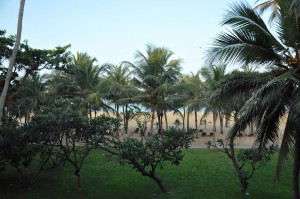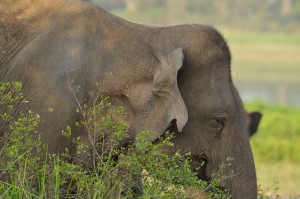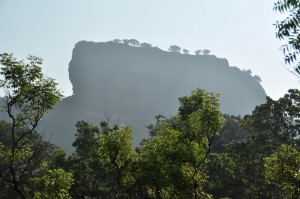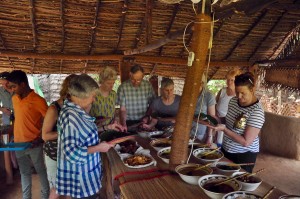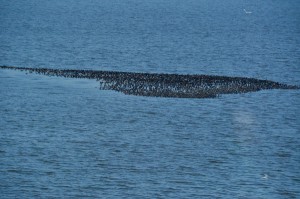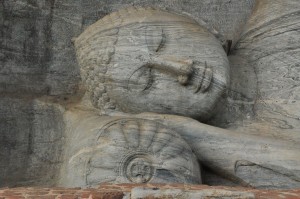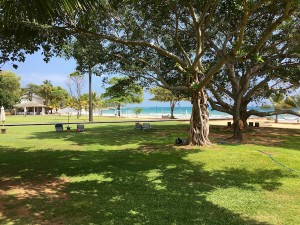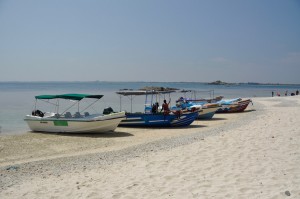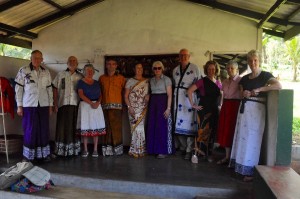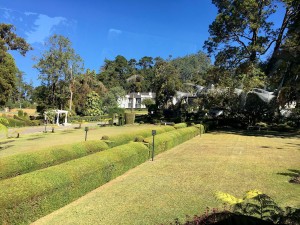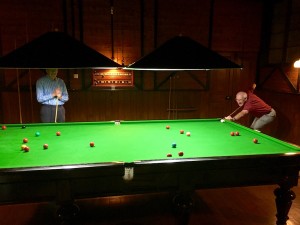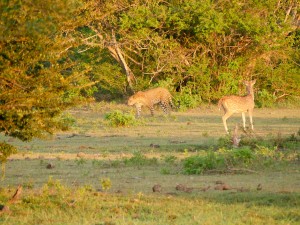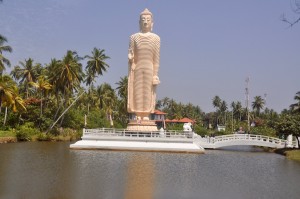Sleep, following the journey, was wonderful. Not only was I ready for it but the enormous bed welcomed and accepted me, offering comfort and super soft pillows. I was fearful that I would not wake up naturally and would be late for breakfast and our planned departure at 8.30. As it happened the early morning light filtered gently through the blinds. I was keen to lift them and see what our outlook was like. Wow! We looked out onto a lawned area dotted with palm trees, the other side of which were pristine golden sands and the sea. The sun was not yet up but the fishermen were in clusters, working rhythmically together to haul their nets, laden with fish, from the sea. It was like watching a slow dance. Unfortunately, there was little time to enjoy this beauty as we had to leave, but I left sure that there would be similarly beautiful places that we would be able to spend more time enjoying.
Leaving Negombo, we picked our way through narrow roads to Pinewella and the elephant orphanage. There has been a linear development virtually all the way on either side of the road. Behind this thin band of housing and businesses the land is green with coconut plantations, rubber plantations, pineapple plantations and rice paddy fields. Every-so-often in this spartan linear development, a new, two or three storey, glass fronted showroom would appear with toilets, or other similarly bizarre objects stacked in the windows.
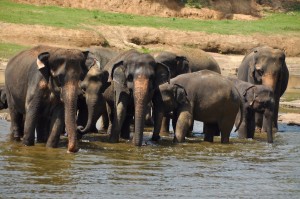 By the time we arrived at Pinewella the elephants were already bathing in the river, so we headed down to watch the spectacle. There was not a lot of water in the river but to compensate there is a fire hose, which sprays water in an arc over the assembled elephants. It is a spectacle but I feel slightly uncomfortable watching it; it is almost turning the elephants into performing circus animals. You have to remind yourself that if Pinewella was not there, then these fifty or so elephants being looked after would all probably be dead, and the money we pay to experience the spectacle helps ensure they have a good a life as possible.
By the time we arrived at Pinewella the elephants were already bathing in the river, so we headed down to watch the spectacle. There was not a lot of water in the river but to compensate there is a fire hose, which sprays water in an arc over the assembled elephants. It is a spectacle but I feel slightly uncomfortable watching it; it is almost turning the elephants into performing circus animals. You have to remind yourself that if Pinewella was not there, then these fifty or so elephants being looked after would all probably be dead, and the money we pay to experience the spectacle helps ensure they have a good a life as possible.
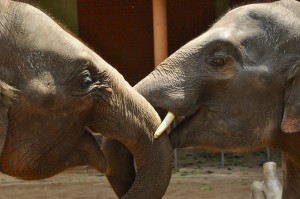 When I last visited the orphanage in 2014, I was disturbed by the number of tourists jostling to feed the baby elephants with bottles of milk. When we left the bathing elephants to go up to the orphanage there seemed to be far fewer tourists and none of the jostling to get close and fuss the animals. Perhaps we arrived too late to see that. There seemed to be more restrictions in place as there was an outbreak of TB among some of the elephants. They are also not taking in any more animals, so the babies I saw three years ago are now that much bigger. The only activity we watched was two young elephants play fighting, just like children. It was enjoyable to watch and gave us nothing but joyous memories as we left to continue our journey.
When I last visited the orphanage in 2014, I was disturbed by the number of tourists jostling to feed the baby elephants with bottles of milk. When we left the bathing elephants to go up to the orphanage there seemed to be far fewer tourists and none of the jostling to get close and fuss the animals. Perhaps we arrived too late to see that. There seemed to be more restrictions in place as there was an outbreak of TB among some of the elephants. They are also not taking in any more animals, so the babies I saw three years ago are now that much bigger. The only activity we watched was two young elephants play fighting, just like children. It was enjoyable to watch and gave us nothing but joyous memories as we left to continue our journey.
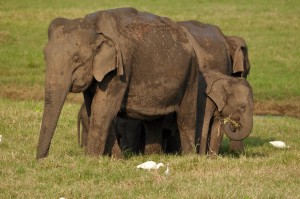 Before we went to our overnight accommodation, we travelled a little further to visit Minneriya Wild Life Sanctuary. Here, we boarded our open top jeeps for a bumpy journey through the park. Water features a lot in the park and it acts as a magnet for the animals that reside within it, particularly elephants and a whole range of birds. This experience proved to be one of the highlights of the whole trip.
Before we went to our overnight accommodation, we travelled a little further to visit Minneriya Wild Life Sanctuary. Here, we boarded our open top jeeps for a bumpy journey through the park. Water features a lot in the park and it acts as a magnet for the animals that reside within it, particularly elephants and a whole range of birds. This experience proved to be one of the highlights of the whole trip.
As we bumped our way around the park we came across several groups of female elephants and their calves. The males tend to be solitary until it is the mating season. The youngsters stayed close to their mothers. On the one occasion that we did come across a male we backed off sharply. They can be quite aggressive at times and this one had been given the name, “Bonnet”. Hardly a manly name for an elephant but the name was born out of the fact that he had a reputation for slamming his trunk down onto the bonnets of any jeep that got too close.
We had already noticed on our travels across Sri Lanka that wherever farm livestock were, egrets were always nearby. There seemed to be a strong relationship between them and cattle, the latter disturbing the ground and releasing all sorts of tasty morsels. The same applied to elephants and buffalo, they were always accompanied by ever attentive egrets.
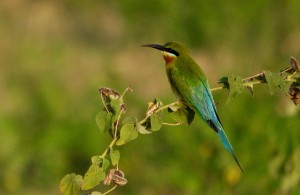 But there were plenty of other birds around the water’s edge, pelican, painted storks, heron, Brahminy Kites and stunningly beautiful bee eaters. The latter we would see perched on small branches, ever alert to their surroundings, occasionally darting off to pick up an insect before returning to the same branch. They were easily predictable and thus became excellent photographic models.
But there were plenty of other birds around the water’s edge, pelican, painted storks, heron, Brahminy Kites and stunningly beautiful bee eaters. The latter we would see perched on small branches, ever alert to their surroundings, occasionally darting off to pick up an insect before returning to the same branch. They were easily predictable and thus became excellent photographic models.
As the sun went down the colours became richer.
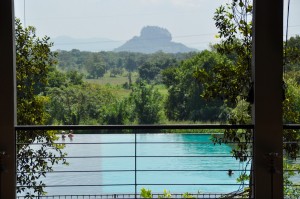 Leaving the park as the sun set, we made our way to our hotel, the Aliya Resort and Spa at Sigiriya. What a stunning place this was; a long flight of shallow steps with water channelled down each side took us to the open reception area. Beyond was an infinity pool and a view of Sigiriya, now fading rapidly as darkness fell. This was a luxurious place in every respect – the spaciousness of the rooms, the positioning of the public places with outstanding views and the wide range of exquisite food to suite every taste. If all hotels were going to be as good as this we were all going to struggle not to put to weight, particularly as there was limited physical activity to burn off the calories.
Leaving the park as the sun set, we made our way to our hotel, the Aliya Resort and Spa at Sigiriya. What a stunning place this was; a long flight of shallow steps with water channelled down each side took us to the open reception area. Beyond was an infinity pool and a view of Sigiriya, now fading rapidly as darkness fell. This was a luxurious place in every respect – the spaciousness of the rooms, the positioning of the public places with outstanding views and the wide range of exquisite food to suite every taste. If all hotels were going to be as good as this we were all going to struggle not to put to weight, particularly as there was limited physical activity to burn off the calories.
The following morning dawned bright and sunny with a chorus of birdsong outside our room.
Following another morning of over-indulged breakfast, we set out to visit and climb Sigiriya, an ancient rock fortress with a fascinating history. There have always been religious significances in Sigiriya but back in the fifth century there was a king who had two sons, one, Moggallana, by the queen, the other, Kasyapa, by one of the King’s consorts. Although Moggallana was the rightful heir, Kasyapa sought an opportunity to seize power. Killing his father, Kasyapa took control of Sigiriya away from the residing monks and moved his capital to Sigiriya, a rock outcrop that could be easily defended. Meanwhile, Moggallana fled to India fearing for his life.
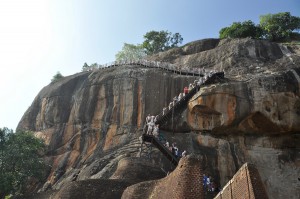 In the next eighteen years Kasyapa built for himself an impenetrable fortress 200m above the surrounding land and further protected it with crocodile infested moats. He always knew that Moggallana would, one day, return. When he did he brought an army with him. Kasyapa, as clever as he was, decided to meet his brother in battle instead of staying put in his fortress. Rain fell heavily, turning the ground to mud, mud that made the elephants at the front of the column slip and slide. Unable to hold their stability the elephants turned away from Moggallana and his army. The rest of Kasyapa’s army, on seeing the elephants flee, thought a retreat had been ordered, turned and fled. Kasyapa was slain and the rock was returned to the Buddhist monks.
In the next eighteen years Kasyapa built for himself an impenetrable fortress 200m above the surrounding land and further protected it with crocodile infested moats. He always knew that Moggallana would, one day, return. When he did he brought an army with him. Kasyapa, as clever as he was, decided to meet his brother in battle instead of staying put in his fortress. Rain fell heavily, turning the ground to mud, mud that made the elephants at the front of the column slip and slide. Unable to hold their stability the elephants turned away from Moggallana and his army. The rest of Kasyapa’s army, on seeing the elephants flee, thought a retreat had been ordered, turned and fled. Kasyapa was slain and the rock was returned to the Buddhist monks.
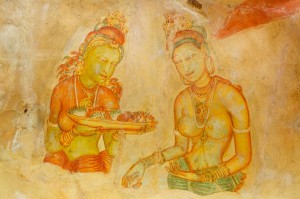 It is a steep climb up many steps. Part way up there is a deviation up a spiral staircase bolted to the rock face, to see some frescos painted on the rock of semi-naked women. These are beautifully done and, of those that are left, are so well preserved. Back in 2014 I could photograph them but today all cameras have to be turned off and put away. The photo opposite was taken three years ago, so I won’t be in trouble for publishing this today. Continuing, we climbed up to a terrace at the foot of the last section of the climb. Here steps had been bolted into the rock, giving a sensation of being very exposed. Adjacent to the steps were the original steps, merely footprints in the rock.
It is a steep climb up many steps. Part way up there is a deviation up a spiral staircase bolted to the rock face, to see some frescos painted on the rock of semi-naked women. These are beautifully done and, of those that are left, are so well preserved. Back in 2014 I could photograph them but today all cameras have to be turned off and put away. The photo opposite was taken three years ago, so I won’t be in trouble for publishing this today. Continuing, we climbed up to a terrace at the foot of the last section of the climb. Here steps had been bolted into the rock, giving a sensation of being very exposed. Adjacent to the steps were the original steps, merely footprints in the rock.
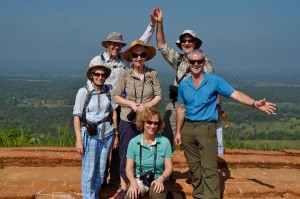 It is a beautiful place with commanding views all around. The down side is that it is on the itinerary of virtually every visitor to Sri Lanka, resulting in crowds. Hence, where hawkers are allowed to go, they gather in crowds and try to sell all sorts of cheap souvenirs. For a few rupees you could wrap a python around your neck. It was also stiflingly hot, so it was a relief to briefly return to the hotel for a quick shower before we embarked on the next part of our itinerary.
It is a beautiful place with commanding views all around. The down side is that it is on the itinerary of virtually every visitor to Sri Lanka, resulting in crowds. Hence, where hawkers are allowed to go, they gather in crowds and try to sell all sorts of cheap souvenirs. For a few rupees you could wrap a python around your neck. It was also stiflingly hot, so it was a relief to briefly return to the hotel for a quick shower before we embarked on the next part of our itinerary.
That was lunch. I am not going to write about all of the meals we had but this one was a bit special. We were on our way to Polonnaruwa, the ancient capital of Sri Lanka. En route we called into a traditional home that produces traditional lunches for passing travellers. This must, by now, be a well known place because there was a constant stream of visitors, like ourselves. Sitting under an open sided thatched shelter, our food was immediately brought to a central table. It included fish and chicken but with bowl after bowl of accompaniments so that our banana leaf plates were straining under such fine food and, of course, we had to try everything.
As we travelled across Sri Lanka we became increasingly aware of a great many lakes, many of which were created by ancient kings to ensure the fertility of the land and for there to be a constant supply. The earthworks to build these were huge and in a day when the only asset was manpower. These reservoirs still fulfil a function today by providing irrigation systems, but also act as a magnet for wildlife.
As we drove to Polonnaruwa we passed one of these huge man made lakes, the road following the route along the top of the earthworks holding back the water. All along the water’s edge, heron and egrets stare, motionless into the water, occasionally making a stab into the water with their long beaks and coming out with a fish firmly clasped. Out in the middle a dark patch appeared on the water, which turned out to be a solid raft of several thousands of cormorants, behaviour I had never witnessed before.
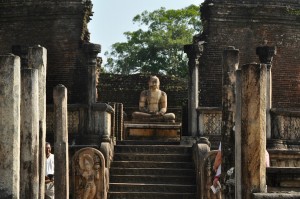 Polonnaruwa was the seat of south Indian Chola and Sinhalese kings almost a thousand years ago. It is rich in culture and history, with the ruins giving us clear pictures of the lives of people during that period. Before we visited the ruins, Sanath, our guide, took us to the archeological museum to give us some background information, to see models of complete temples and to learn something of the history. We then walked from temple to temple, all with their own specific orientation, giant Buddhas made of hand crafted bricks and covered in plaster. The quality of workmanship and the techniques needed were way ahead of their time. Ancient streets were revealed with the foundations of shops on either side, suggesting the city of wealth.
Polonnaruwa was the seat of south Indian Chola and Sinhalese kings almost a thousand years ago. It is rich in culture and history, with the ruins giving us clear pictures of the lives of people during that period. Before we visited the ruins, Sanath, our guide, took us to the archeological museum to give us some background information, to see models of complete temples and to learn something of the history. We then walked from temple to temple, all with their own specific orientation, giant Buddhas made of hand crafted bricks and covered in plaster. The quality of workmanship and the techniques needed were way ahead of their time. Ancient streets were revealed with the foundations of shops on either side, suggesting the city of wealth.
The highlight was Gal Vihara, three huge stone statues of Buddha, carved out of the cliffs, in sitting, standing and reclining positions. They are beautiful, with the lines of strata giving texture to the statues. The serenity of the faces captures the whole essence of Buddhism and it seemed only right to take a little time out to sit on the rocks opposite the statues to gaze and to contemplate.
It was a shame that we had visited two very important heritage sites on the same day. We could have spent much longer at Polonnaruwa, to give us more time to absorb and understand the history and culture.
On the way back a number of us were going to de-stress with an Ayurvedic massage but because of some confusion as to the venue it never happened and we remained stressed.
The following morning we left the luxury of the Aliya Resort (4*) and headed north east to Trincomalee for a bit of slumming it in a 3* hotel. Trinco Blu Hotel was far from slumming it for here the coast is beautiful with long stretches of white, sandy beaches and warm seas. Our room opened out onto the gardens that preceded the beach. In the centre of the gardens was an inviting pool. The staff were all friendly, welcoming and informative, so much so that many of us booked for an Ayurvedic massage and a trip out to Pigeon Island for a snorkelling opportunity on the coral reef. One could not ask for more. Here we could relax more, swim, wander along the beach to a small estuary with mangroves on one shore, fishing boats sitting in the sand on the other, all overlooked by a temple.
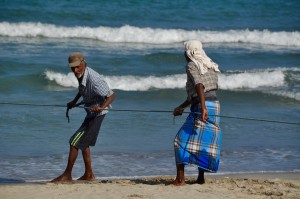 In the evening, and again the following morning, we were able to watch the fishermen pulling in their nets. The nets were placed, perhaps a quarter of a mile off shore. Either end was brought to the beach by a boat, to be hauled in by a group of fishermen. As they followed a rhythm they gradually pulled the net in. It was a long process, longer if the net was full and heavy. It was like watching a dance and they all worked rhythmically as a team. I would have loved to get involved but it was a long process and I really did not have the time. Anybody who does help haul in the net is given a fish as their reward. Not sure what I would have done with it.
In the evening, and again the following morning, we were able to watch the fishermen pulling in their nets. The nets were placed, perhaps a quarter of a mile off shore. Either end was brought to the beach by a boat, to be hauled in by a group of fishermen. As they followed a rhythm they gradually pulled the net in. It was a long process, longer if the net was full and heavy. It was like watching a dance and they all worked rhythmically as a team. I would have loved to get involved but it was a long process and I really did not have the time. Anybody who does help haul in the net is given a fish as their reward. Not sure what I would have done with it.
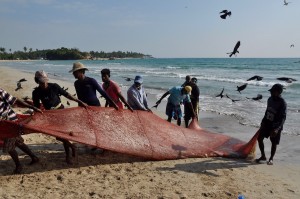 After a relaxing afternoon, Angela and I went for a joint Ayurvedic massage. Having been introduced to our respective masseurs we were given time to change out of our clothes and into a pair of paper pants. They looked like the sort of hat worn by a food processor, only it had two holes for our legs. Needless to say we looked a sight and both of us got a fit of the giggles in time for our returning masseurs. The experience was a mixture of relaxing pleasure with moments of intense pain as pressure was applied. Oh, and there were also one or two ticklish moments. I think, overall, it was an enjoyable experience. As there are no pictures of this I have inserted a fishing photo; a much better image.
After a relaxing afternoon, Angela and I went for a joint Ayurvedic massage. Having been introduced to our respective masseurs we were given time to change out of our clothes and into a pair of paper pants. They looked like the sort of hat worn by a food processor, only it had two holes for our legs. Needless to say we looked a sight and both of us got a fit of the giggles in time for our returning masseurs. The experience was a mixture of relaxing pleasure with moments of intense pain as pressure was applied. Oh, and there were also one or two ticklish moments. I think, overall, it was an enjoyable experience. As there are no pictures of this I have inserted a fishing photo; a much better image.
The following morning, nine of us kitted ourselves out with flippers, masks and snorkels before heading down to the beach to help launch our boat and head out to Pigeon Island, a journey of about half an hour. It really was an idyllic spot, although we were not alone as several boats from other resorts were also there.
Prior to entering the water, awkwardly walking backwards over broken coral, we were warned that there were a few jelly fish in the water so we should try to avoid them as their sting is uncomfortable. We were told they were dangerous. This information took a little bit of the pleasure out of the adventure as we were constantly on the lookout for and taking evasive action for jelly fish. As well as lots of colourful fish we also saw turtle and a couple of reef sharks that must have been four or five feet long. I was disappointed I had not brought my underwater Gopro to Sri Lanka. Although there was some really beautiful violet coloured coral, quite a lot of it was dead, and I am sure that our presence there was not helping.
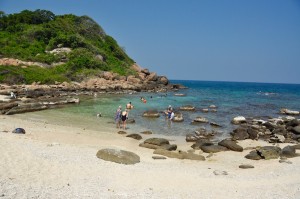 After about an hour in the water, the inevitable happened and three members of the team were stung by jelly fish. There was an element of panic as we had been told they were dangerous. However, there seemed to be no urgency among our crew to get the victims quickly back to shore. After a lot of effort and guidance from ourselves we managed to get everybody ashore where the crew applied some vinegar, which initially seemed to ease the pain. The stings had left some very angry looking wheels around the point of contact.
After about an hour in the water, the inevitable happened and three members of the team were stung by jelly fish. There was an element of panic as we had been told they were dangerous. However, there seemed to be no urgency among our crew to get the victims quickly back to shore. After a lot of effort and guidance from ourselves we managed to get everybody ashore where the crew applied some vinegar, which initially seemed to ease the pain. The stings had left some very angry looking wheels around the point of contact.
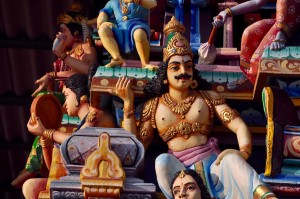 After some beach time we returned to our hotel, more relaxation before heading to the Hindu temple of Konesvaram, built on a rocky outcrop just to the north of Trincomalee. When the Portuguese took control of Sri Lanka in the 16th Century they destroyed many of the temples and Buddhist icons in their search for treasure. This happened at Konesvaram where they threw the whole temple over the cliffs and into the sea, as they dismantled it in their search. The present temple was rebuilt post Portuguese, during the occupation of the the Dutch. The temple is similar to those found in southern India with towers full of story telling characters in pastel shades and rather gaudy statues with frightening personas and a tendency to be blue. While we were there we were able to mingle among the devotees and experience at close hand some of their rituals. Whilst I find it all very interesting and admire their faith, I must confess to understanding very little.
After some beach time we returned to our hotel, more relaxation before heading to the Hindu temple of Konesvaram, built on a rocky outcrop just to the north of Trincomalee. When the Portuguese took control of Sri Lanka in the 16th Century they destroyed many of the temples and Buddhist icons in their search for treasure. This happened at Konesvaram where they threw the whole temple over the cliffs and into the sea, as they dismantled it in their search. The present temple was rebuilt post Portuguese, during the occupation of the the Dutch. The temple is similar to those found in southern India with towers full of story telling characters in pastel shades and rather gaudy statues with frightening personas and a tendency to be blue. While we were there we were able to mingle among the devotees and experience at close hand some of their rituals. Whilst I find it all very interesting and admire their faith, I must confess to understanding very little.
The following morning we headed south, our destination, Kandy, in the heart of the hill country and tea plantations. I was beginning to feel some concern for Sally’s reaction to her jelly fish sting. While Angela’s and Richard’s looked angry, Sally’s hand and lower arm was beginning to swell alarmingly and she was in some considerable pain.
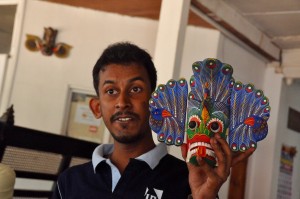 Our journey was punctuated with a number of stops along the route, to a wood carvers, a spice garden and a batik workshop. Whilst the wood carving was interesting it proved to be quite expensive, which diminished one’s interest in it. The spice garden was much more interesting. We walked around a garden, with a guide, showing us a whole range of plants and telling us of their medical or culinary uses. Later, in a room, we smelt and felt various products and were all treated to a free, five minute, head and shoulders massage. In the shop we bought a number of remedies, despite the high cost, a cost that was only realised once the money had changed hands.
Our journey was punctuated with a number of stops along the route, to a wood carvers, a spice garden and a batik workshop. Whilst the wood carving was interesting it proved to be quite expensive, which diminished one’s interest in it. The spice garden was much more interesting. We walked around a garden, with a guide, showing us a whole range of plants and telling us of their medical or culinary uses. Later, in a room, we smelt and felt various products and were all treated to a free, five minute, head and shoulders massage. In the shop we bought a number of remedies, despite the high cost, a cost that was only realised once the money had changed hands.
Watching the production of batik garments and pictures was particularly interesting, requiring a significant amount of skill. The work is largely carried out by women of middle age and beyond, and one cannot help but wonder how long this craft will continue without young recruits learning and taking on the skills. While the working conditions are uncomfortable at best, with strong chemical smells from the paint, hot wax and even hotter water above wood burning stoves it is not likely to attract the next generation. There were some beautiful examples of their work, and in order to attract us into buying some we were all dressed in batik outfits.
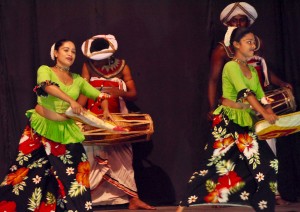 Reaching Kandy, we immediately when to a theatre to watch a cultural show. The theatre was packed and by the time we arrived we were very near the back. The programme was not too long and all the dances were quite snappy. I’m not sure whether they were all choreographed or improvised. The entertainment ended with a bit of fire eating and fire walking, neither of which we could see very clearly.
Reaching Kandy, we immediately when to a theatre to watch a cultural show. The theatre was packed and by the time we arrived we were very near the back. The programme was not too long and all the dances were quite snappy. I’m not sure whether they were all choreographed or improvised. The entertainment ended with a bit of fire eating and fire walking, neither of which we could see very clearly.
Adjourning to our hotel, the 5* Cinnamon Citadel, an excellent hotel in a good setting but not a very friendly attitude, and even less friendly clientele who all had plums in the their mouths and thought everybody should stand aside for them. As dusk fell I enjoyed watching thousands of fruit bats fly across our balcony on their nightly search for food.
We were becoming more concerned about Sally’s hand and arm. Her fingers were cold, suggesting no circulation, so we called a doctor to the hotel, who, it turned out, had no serious advice or remedy but was more than willing to take his $50 fee. In hindsight, if he had been a little more pro-active we might have avoided some of the worries that followed.
The following morning Sally’s condition had deteriorated further and action had to be taken as a matter of urgency. Abandoning our plans, Sanath took Sally to the hospital, where, after a degree of travelling between departments and hospitals, Sally was admitted.
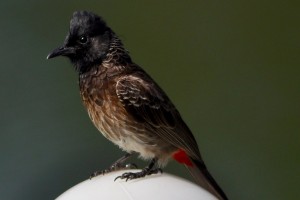 Initially we waited for news in the gardens of the hotel overlooking the river. The bird life was abundant with kingfishers darting from branch to water and back to branch, kites flying overhead, very tame red vented bulbuls and similarly tame red wattled plovers who tended to come to meet us as we approached.
Initially we waited for news in the gardens of the hotel overlooking the river. The bird life was abundant with kingfishers darting from branch to water and back to branch, kites flying overhead, very tame red vented bulbuls and similarly tame red wattled plovers who tended to come to meet us as we approached.
It soon became apparent that we were going to have to shelve our plans for the day. We would not be able to visit the Temple of the Tooth as Sanath was so preoccupied in getting Sally settled. He even had to buy bedding for her. A dark cloud hung over the group.
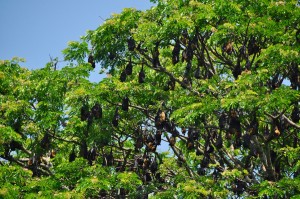 At Sanath’s suggestion we went to the Botanical Gardens in Kandy to await news. These are beautifully laid out gardens with lots of exotic plants and trees, massive bamboos, Mimosa in full bloom (for a while I called the Samosa!) Along the river’s edge were some tall trees absolutely covered in hanging bats, the same bats I had seen the previous evening as they ventured out on their nightly search for food. There were so many of them that some of the branches were straining under their weight. As they sleep, they are not silent. Nor are they still, as they stretch and occasionally fly off to return a few moments later.
At Sanath’s suggestion we went to the Botanical Gardens in Kandy to await news. These are beautifully laid out gardens with lots of exotic plants and trees, massive bamboos, Mimosa in full bloom (for a while I called the Samosa!) Along the river’s edge were some tall trees absolutely covered in hanging bats, the same bats I had seen the previous evening as they ventured out on their nightly search for food. There were so many of them that some of the branches were straining under their weight. As they sleep, they are not silent. Nor are they still, as they stretch and occasionally fly off to return a few moments later.
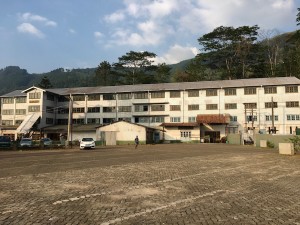 Eventually, Sanath rejoined us, having finally got Sally comfortable in hospital and her beginning to receive the treatment she so desperately needed. While we were now able to continue with our itinerary and head to a tea plantation en route to Nuwara Eliya, I was now preoccupied with conversations with Sally’s insurance company and medical assistance. While all this was going on, the rest of the group had a guided tour around a tea factory. Despite the fact that we had a guide, Sanath could not help but get involved as he had spent twenty eight years working in the tea industry.
Eventually, Sanath rejoined us, having finally got Sally comfortable in hospital and her beginning to receive the treatment she so desperately needed. While we were now able to continue with our itinerary and head to a tea plantation en route to Nuwara Eliya, I was now preoccupied with conversations with Sally’s insurance company and medical assistance. While all this was going on, the rest of the group had a guided tour around a tea factory. Despite the fact that we had a guide, Sanath could not help but get involved as he had spent twenty eight years working in the tea industry.
Nuwara Elia is a little slice of England in the middle of the Sri Lankan hill district. There are mock Georgian houses, some of which are splendid hotels. We were staying in St Andrew’s with wood panelled walls, roaring log fires, manicured gardens and a snooker room. A golf course ran through the middle of town, crossing the road on several occasions. After, what for me had been a fairly stressful day, what better way to unwind than a game of snooker as a foursome. I don’t think I have ever played on a full size table before. I partnered Richard because he said he had played before and we were against David and Simon.
It cost 600 Rupees for forty five minutes. At the end of that forty five minutes the score was 27 – 17 in favour of David and Simon. There were still some reds on the table. We were the four most inept snooker players in the world but it was the funniest evening I have spent in a long time. We were dreadful. Our wives watched with mixed emotions of mirth and shame. Our laughter could be heard throughout the hotel. Afterwards, Richard confessed to not being able to see very clearly through one eye, the eye I suspect he kept open when playing his shot.
The following morning we continued our journey, heading south east and dropping down to the coastal plain and Yala National Park. It was a series of jungle lodges spreading out from a central complex of reception, restaurant, bar and pool overlooking a lake inhabited by crocodiles, numerous birds and occasionally visited by elephants. The roar of the sea, just behind the lodges could always be heard.
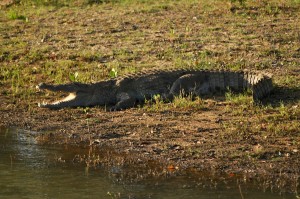 Staying here proved to be one of the highlights of the trip. As soon as we arrived, and before we checked in, we met our jeep drivers and we set out on an afternoon safari into the park. It was wonderful to see so much wildlife and there were very few periods where there was nothing to see. Unlike Minneriya, where we saw lots of groups of elephants, here we tended to see single males. There are numerous pools and water holes, all acting as a magnet to the animals. Crocodiles lay at the water’s edge with their mouths open while others lingered in the water with the minimum of scaly skin showing above the surface. Water buffalo wallowed, keeping cool in the strong afternoon sun. And all the while birds waded in the shallows. Bee eaters stood on slender twigs, scanning their surroundings, darting after something and returning to their look out post. Unless you were an insect or a small fish there seemed to be complete harmony among the animals; no one animal was threatening another and, although they were all watchful, they seemed at peace with each other. I am sure it is not always thus.
Staying here proved to be one of the highlights of the trip. As soon as we arrived, and before we checked in, we met our jeep drivers and we set out on an afternoon safari into the park. It was wonderful to see so much wildlife and there were very few periods where there was nothing to see. Unlike Minneriya, where we saw lots of groups of elephants, here we tended to see single males. There are numerous pools and water holes, all acting as a magnet to the animals. Crocodiles lay at the water’s edge with their mouths open while others lingered in the water with the minimum of scaly skin showing above the surface. Water buffalo wallowed, keeping cool in the strong afternoon sun. And all the while birds waded in the shallows. Bee eaters stood on slender twigs, scanning their surroundings, darting after something and returning to their look out post. Unless you were an insect or a small fish there seemed to be complete harmony among the animals; no one animal was threatening another and, although they were all watchful, they seemed at peace with each other. I am sure it is not always thus.
 Two hours into the safari we came to a point by the beach where we could stretch our legs. It was also the site of a memorial sculpture to the 2004 tsunami. It was very simple and consisted of four sheets of metal in the shape of a wave, each one indicating the height of the four waves that swept in and 8.30am on Boxing Day 2004. While animals sensed what was to come and ran, flew or climbed trees to escape, 28,000 Sri Lankans and tourists died that day. In the days to come we were to learn more about, and see the effects of, that terrible tsunami.
Two hours into the safari we came to a point by the beach where we could stretch our legs. It was also the site of a memorial sculpture to the 2004 tsunami. It was very simple and consisted of four sheets of metal in the shape of a wave, each one indicating the height of the four waves that swept in and 8.30am on Boxing Day 2004. While animals sensed what was to come and ran, flew or climbed trees to escape, 28,000 Sri Lankans and tourists died that day. In the days to come we were to learn more about, and see the effects of, that terrible tsunami.
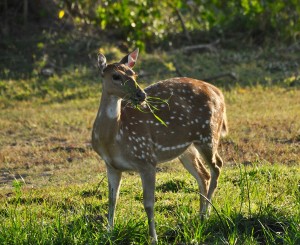 Towards the end of our safari we came across some deer grazing. Suddenly they looked up as one, all facing the same direction, stood stock still and watched. They are always a pretty good indicator of what we really wanted to see, a leopard. We were lucky, for strolling among the bushes was a leopard, not necessarily stalking the deer but perhaps keeping them on their toes. No sooner did we see it that it disappeared again and no photographs could be taken. But, at least we had seen one. There are only twenty five in the vastness of Yala National Park and we had managed to see one of these very elusive cats.
Towards the end of our safari we came across some deer grazing. Suddenly they looked up as one, all facing the same direction, stood stock still and watched. They are always a pretty good indicator of what we really wanted to see, a leopard. We were lucky, for strolling among the bushes was a leopard, not necessarily stalking the deer but perhaps keeping them on their toes. No sooner did we see it that it disappeared again and no photographs could be taken. But, at least we had seen one. There are only twenty five in the vastness of Yala National Park and we had managed to see one of these very elusive cats.
Back at the lodge we were told that when we wanted to come to the restaurant for dinner we were to contact reception and they would send a guide. We weren’t likely to get lost but there was a fair chance that we might bump into an elephant, a buffalo or a wild boar. The same service was provided when we wanted to return to our lodge. This service was only available during the hours of darkness. In daylight hours we came across numerous monitor lizards and, on one occasion, a very large male wild boar asleep by the veranda of a lodge with the occupants sitting on their veranda watching it, closely.
Sally was still causing us some concern and it became apparent that the hospital in Kandy did not really have the resources to be able to deal with her appropriately. After several more conversations with the medical assistance centre in France it was agreed that, as a matter of urgency, she should be transferred to Colombo. However, France could not get an ambulance there quickly and asked if I could get one quicker. There was one at the hospital where Sally was but they could not release it without confirmation from France. The Sri Lankans could not understand English spoken with a French accent, so Sally ended up waiting seven hours while ever more frantic phone calls went back and forth. At one point I was told by France that Sally had been picked up by the ambulance and was on her way to Colombo. A few minutes later Sally phoned me to say she was still waiting. It got more and more frustrating and exasperating, until, eventually, Sally was on her way. She was operated on at 1.30 in the morning, shortly after arriving at the hospital in Colombo.
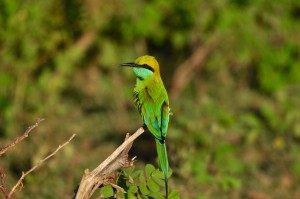 Our second safari was an early morning one, rising at 4.30am, leaving at 5.00am and entering the park at 6.00am. There were a great many jeeps waiting to enter the park but as we all filtered in through the gate they soon dispersed and it did not feel at all crowded. To begin with it was all fairly quiet, not even the animals were up this early but as the safari progressed we saw more and more. We again saw a two leopards, each time those excellent leopard indicators, deer, alerting us to their presence. Still no photographs. I was using my large lens, which is unwieldy without a tripod and difficult to focus. By the time I got myself sorted, the leopard had gone on both occasions. I’ll allow David and Sandie, who both got pictures, to gloat over that one.
Our second safari was an early morning one, rising at 4.30am, leaving at 5.00am and entering the park at 6.00am. There were a great many jeeps waiting to enter the park but as we all filtered in through the gate they soon dispersed and it did not feel at all crowded. To begin with it was all fairly quiet, not even the animals were up this early but as the safari progressed we saw more and more. We again saw a two leopards, each time those excellent leopard indicators, deer, alerting us to their presence. Still no photographs. I was using my large lens, which is unwieldy without a tripod and difficult to focus. By the time I got myself sorted, the leopard had gone on both occasions. I’ll allow David and Sandie, who both got pictures, to gloat over that one.
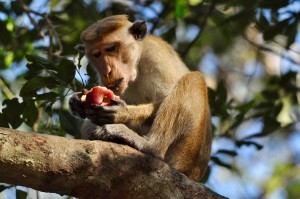 We were carrying a picnic breakfast and after a couple of hours, as before, we stopped for a leg stretch and a bite to eat. This was not in the same place as we previously stopped. In the trees there was a waiting reception of monkeys, Toque Macaques, looking very cute and innocent. This was so far from the truth. They obviously recognise the white, cardboard picnic boxes. They bided their time, waiting for an opportunity to strike. They would change position, distract us and pounce. I did not eat all of my breakfast so I packed it up and put the box under my seat. No sooner had I turned my back that a monkey was in the jeep, under the seat, taking out my apple. Another followed and stole my satsuma. The final act of bravery came when I was sitting in my seat and a monkey leapt into the jeep, under my seat and stole from my box. I reacted, the monkey leapt from the jeep, turned from its position in an adjacent tree and bared its teeth at me. How rude.
We were carrying a picnic breakfast and after a couple of hours, as before, we stopped for a leg stretch and a bite to eat. This was not in the same place as we previously stopped. In the trees there was a waiting reception of monkeys, Toque Macaques, looking very cute and innocent. This was so far from the truth. They obviously recognise the white, cardboard picnic boxes. They bided their time, waiting for an opportunity to strike. They would change position, distract us and pounce. I did not eat all of my breakfast so I packed it up and put the box under my seat. No sooner had I turned my back that a monkey was in the jeep, under the seat, taking out my apple. Another followed and stole my satsuma. The final act of bravery came when I was sitting in my seat and a monkey leapt into the jeep, under my seat and stole from my box. I reacted, the monkey leapt from the jeep, turned from its position in an adjacent tree and bared its teeth at me. How rude.
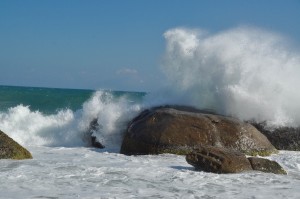 In the afternoon, Angela and I strolled down to the beach, first checking in with the security guard in case there were any elephants we needed to avoid. It was a beautiful beach with numerous rounded rocks at the water’s edge, looking like the rounded backs of mighty elephants. The waves of the Indian Ocean crashed over them spectacularly. It was not a particularly windy afternoon but the power of the ocean was awesome and nobody in their right mind would even consider entering it.
In the afternoon, Angela and I strolled down to the beach, first checking in with the security guard in case there were any elephants we needed to avoid. It was a beautiful beach with numerous rounded rocks at the water’s edge, looking like the rounded backs of mighty elephants. The waves of the Indian Ocean crashed over them spectacularly. It was not a particularly windy afternoon but the power of the ocean was awesome and nobody in their right mind would even consider entering it.
Later in the afternoon a bull elephant strolled across the shore line of the lake, close to the swimming pool, in full view of all relaxing around the pool.
We could have stayed in Yala longer but we needed to continue our journey around the south coast, before heading inland and climbing into the rainforest This was the only day we had any rain but it did not come to much.
 When we arrived at the Eco Lodge low cloud hung about the tree tops. Our accommodation was old shipping containers converted into comfortable en-suite bedrooms. A novel idea. This was the only hotel where we did not have buffet style meals. There was a set menu. This made a pleasant change, the moreso because the food really was gourmet. It happened to be Valentine’s Day, the day we arrived, and the starter and sweet had an appropriate theme to them. They acted as useful reminders for the males in the group to be especially kind to their wives! Otherwise we would never have remembered it was Valentine’s Day.
When we arrived at the Eco Lodge low cloud hung about the tree tops. Our accommodation was old shipping containers converted into comfortable en-suite bedrooms. A novel idea. This was the only hotel where we did not have buffet style meals. There was a set menu. This made a pleasant change, the moreso because the food really was gourmet. It happened to be Valentine’s Day, the day we arrived, and the starter and sweet had an appropriate theme to them. They acted as useful reminders for the males in the group to be especially kind to their wives! Otherwise we would never have remembered it was Valentine’s Day.
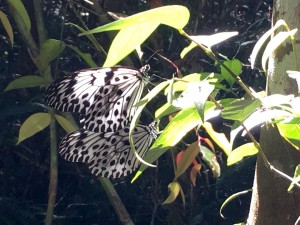 The following morning we went for a guided walk through the rainforest. If you expect to see a lot on one of these walks you will be disappointed. The forest is so dense that views are seriously restricted. Birdsong can be heard but it is virtually impossible to see any of them. Purple Faced Leaf Monkeys live in the forest but we would only see them if they came in the vicinity of the lodge. In the forest, they are invisible. Horizons reduce significantly and we were resigned to looking for small things at our feet, like a skink, or butterflies at eye level. There were some interesting pitcher plants and orchids.
The following morning we went for a guided walk through the rainforest. If you expect to see a lot on one of these walks you will be disappointed. The forest is so dense that views are seriously restricted. Birdsong can be heard but it is virtually impossible to see any of them. Purple Faced Leaf Monkeys live in the forest but we would only see them if they came in the vicinity of the lodge. In the forest, they are invisible. Horizons reduce significantly and we were resigned to looking for small things at our feet, like a skink, or butterflies at eye level. There were some interesting pitcher plants and orchids.
Although the lodge advertises a number of activities, most were not available. We would have liked to have gone to a waterfall and swum in a pool, but there was no water. There has been very little rain, despite it being a rainforest. The night walks were not happening. It presented itself with so much promise, but failed to deliver on activity.
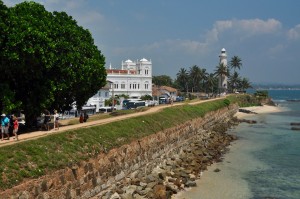 We were now on the last leg of our Sri Lankan journey, heading back down to the south coast and Galle. Galle has always been a port but it reached its peak during the time of the Dutch occupation when a fort was built, the walls of which rise out of the sea. Interestingly, when the tsunami struck the walls protected the old town within but not the more modern town beyond the walls.
We were now on the last leg of our Sri Lankan journey, heading back down to the south coast and Galle. Galle has always been a port but it reached its peak during the time of the Dutch occupation when a fort was built, the walls of which rise out of the sea. Interestingly, when the tsunami struck the walls protected the old town within but not the more modern town beyond the walls.
We visited the Dutch Reformed Church, a rather plain, austere building. Many of the gravestones in the floor of the church bear the symbol of the skull and crossbones, not signifying that the incumbent body was a pirate but someone who died of fever. From there we walked around the walls, passing the lighthouse until we reached a restaurant for lunch. Because Galle has so much historical significance, it does attract a lot of tourists, certainly more than we had encountered since we were at Sigiriya. I was pleased to leave and head a little way up the coast to Hikkaduwa.
All along the coast were reminders of the tsunami, from damaged, rotting sea front properties to little clusters of headstones marking where victims were buried, not on consecrated ground but more likely where they died. This area is where the majority of the victims were. A thousand of them were travelling on a train about 100 metres behind the shoreline when it got swept away.
It would appear that there was no warning. Hotel restaurants were full of people enjoying their Boxing Day breakfast. Nobody understood the signs as the sea retreated rapidly from the shore, leaving fish stranded and flapping on the beach. People went out on to the beach to collect the fish, to watch the spectacle, and when they realised what was about to happen, it was too late.
The hotel where we were staying at Hikkaduwa was one that suffered, being right on the shoreline, in a particularly vulnerable spot. It was a lovely hotel but it tended to cater for a lot of one week package tours of people who only wanted to lounge around the pool and bar area for the duration of their stay. Turtles came up to the water’s edge and became playthings for tourists to feed seaweed to and fondle. It was playing with nature.
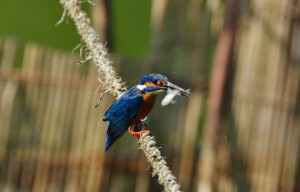 I was pleased, then, on our last day, when Sanath wanted to take us on a river safari. Here, a boat, with a sometimes smelly outboard motor, took us through the mangroves, which act as fish nurseries, where the fry can grow in relative safety before they head out into open water. On the narrower stretches there a fish traps set by fishermen. It was on one of these that we met the best fisher of all, a beautiful kingfisher. It sat on a pole with its beady eyes firmly fixed on the water below. In a flash it dived into the water to emerge with a fish between its beak. It perched just next to us on a rope, holding the fish, then with a flailing of its wings and a jerk of it head, the fish was gone. It was such a treat to witness this at close quarters.
I was pleased, then, on our last day, when Sanath wanted to take us on a river safari. Here, a boat, with a sometimes smelly outboard motor, took us through the mangroves, which act as fish nurseries, where the fry can grow in relative safety before they head out into open water. On the narrower stretches there a fish traps set by fishermen. It was on one of these that we met the best fisher of all, a beautiful kingfisher. It sat on a pole with its beady eyes firmly fixed on the water below. In a flash it dived into the water to emerge with a fish between its beak. It perched just next to us on a rope, holding the fish, then with a flailing of its wings and a jerk of it head, the fish was gone. It was such a treat to witness this at close quarters.
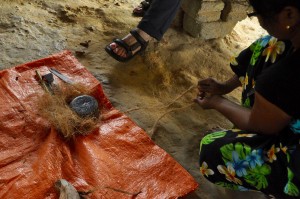 There are many islands in these waters, Cinnamon Island being one of them. here a family lives, growing cinnamon, harvesting it, creating cinnamon sticks, powder and oil to sell to passing visitors. Members of the family gave demonstrations as to how they process the crop. The fresh cinnamon smelt beautiful. They also showed how to make string out of coconut fibres and how they weaved palm leaves. The string was incredibly strong and the leaves, if triple layered, keep any water out. The island has no electricity, or any of the benefits of modern living, but they seemed to have what they wanted. And there is hope that the tradition will continue as the children are all involved.
There are many islands in these waters, Cinnamon Island being one of them. here a family lives, growing cinnamon, harvesting it, creating cinnamon sticks, powder and oil to sell to passing visitors. Members of the family gave demonstrations as to how they process the crop. The fresh cinnamon smelt beautiful. They also showed how to make string out of coconut fibres and how they weaved palm leaves. The string was incredibly strong and the leaves, if triple layered, keep any water out. The island has no electricity, or any of the benefits of modern living, but they seemed to have what they wanted. And there is hope that the tradition will continue as the children are all involved.
Another island had a Buddhist temple on it and large squirrels that like bananas. We landed, armed with bananas but the squirrels had obviously already had their fill and lay on branches and beams looking bloated and content.
On our way back we called in at a floating fish pedicure centre. The raft is divided up into a number of tanks, each with a multitude of fish in. We were told to avoid the larger fish. There was one tank with a couple of fish about eighteen inches long. You would need to count your toes afterwards.
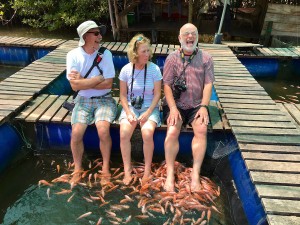 Most people readily dangled their feet into the tanks. As they did so the fish churned the water up in their eager frenzy to get at some dead skin. It is not something that I have ever craved to do but, when the opportunity arises, you have to take it. Even before my feet were anywhere near the water the fish gathered, their gaping mouths held in anticipation. I have never really considered my feet to be particularly sensitive or ticklish, but the sensation the fish caused sent me into paroxysms of uncontrollable laughter. It was so very funny. I couldn’t stand it for long. I had to give my feet a rest before trying again. I thought the second time would be easier but, if anything, it was worse. I don’t think I will be rushing to have fish therapy again.
Most people readily dangled their feet into the tanks. As they did so the fish churned the water up in their eager frenzy to get at some dead skin. It is not something that I have ever craved to do but, when the opportunity arises, you have to take it. Even before my feet were anywhere near the water the fish gathered, their gaping mouths held in anticipation. I have never really considered my feet to be particularly sensitive or ticklish, but the sensation the fish caused sent me into paroxysms of uncontrollable laughter. It was so very funny. I couldn’t stand it for long. I had to give my feet a rest before trying again. I thought the second time would be easier but, if anything, it was worse. I don’t think I will be rushing to have fish therapy again.
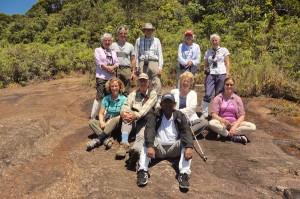 And that was about that. We had crammed so much into our two weeks in Sri Lanka, a country that is truly beautiful from the stunning beaches to the national parks and reserves teaming with wildlife, from the historical sites steeped in legend to the ever smiling people of today, from the rainforest to the tea plantations and, wherever we went, the sumptuous food. Sanath was a brilliant guide and he pitched it just right. However, the most important part of any trip is the people you share it with. Despite one or two stressful moments (Sally is making a good recovery) we laughed together a great deal. The company was great and we had a lot of fun together. Where shall we go next?
And that was about that. We had crammed so much into our two weeks in Sri Lanka, a country that is truly beautiful from the stunning beaches to the national parks and reserves teaming with wildlife, from the historical sites steeped in legend to the ever smiling people of today, from the rainforest to the tea plantations and, wherever we went, the sumptuous food. Sanath was a brilliant guide and he pitched it just right. However, the most important part of any trip is the people you share it with. Despite one or two stressful moments (Sally is making a good recovery) we laughed together a great deal. The company was great and we had a lot of fun together. Where shall we go next?

